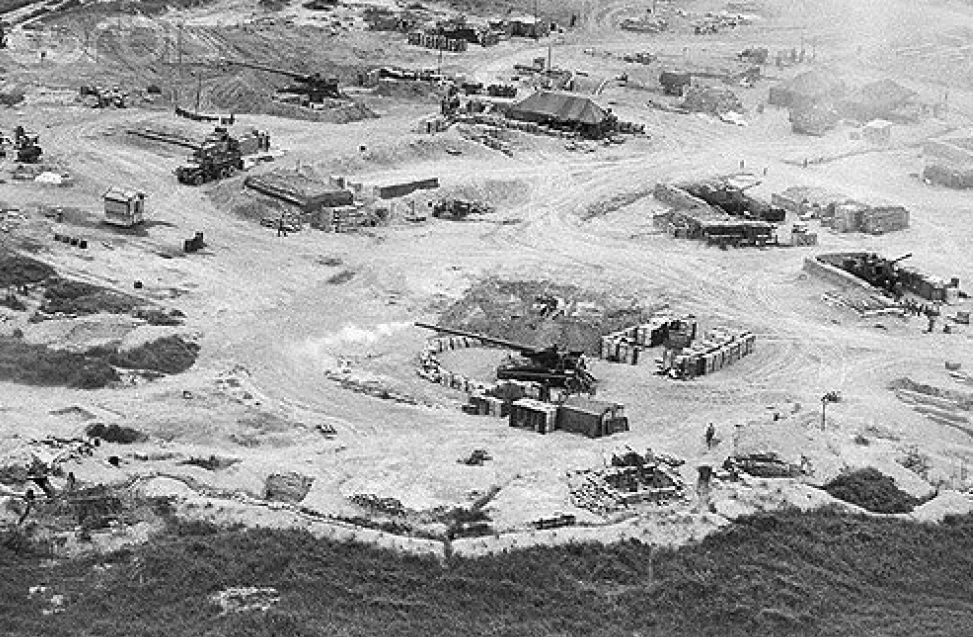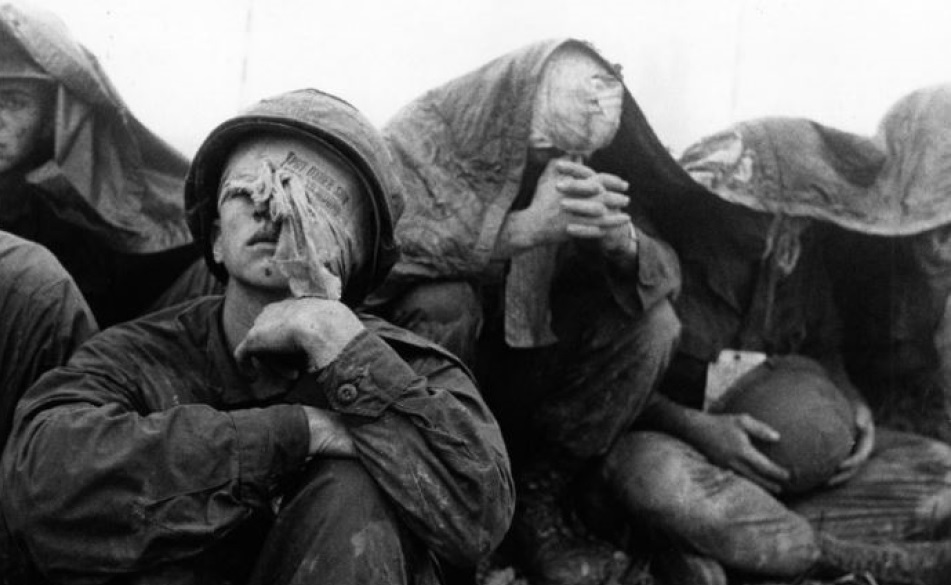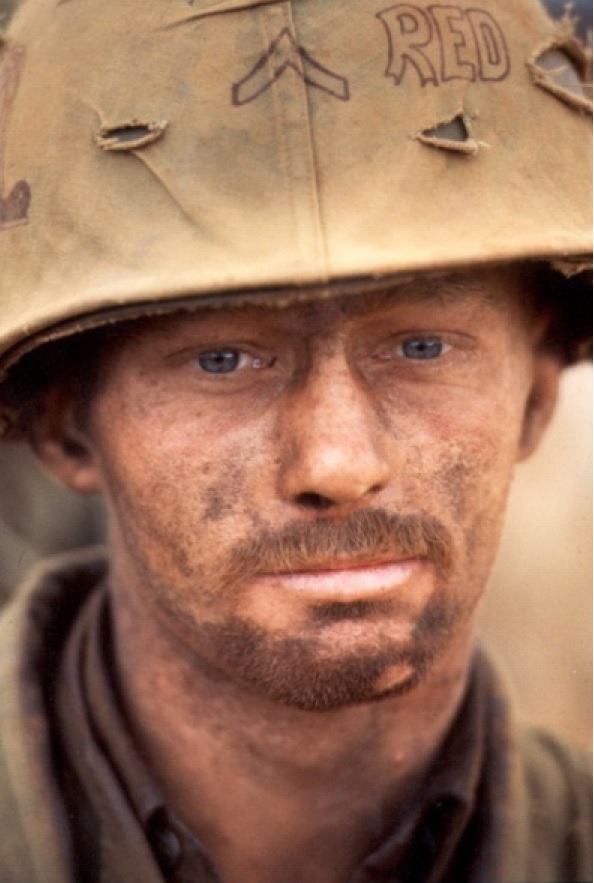A strategic position not to be missed
Khe Sanh was a position of strategic importance in the western mountains of Quang Tri, located on a plateau of nearly 10km each. It was an important base to prevent from the North's support to the South, a barrier to keep the eastern area, Road 9, protect the residential area of coastal plain of Quang Tri province. In the eyes of the American generals, Khe Sanh was a patrol base to prevent the North's main force from penetrating from Laos along Road 9; was a base for operations of the special force of US and puppets to raid our bases in Laos; was an airport serving the reconnaissance of the strategic air route of Truong Son.

Photo: An ammunition bay of the US army in Khe Sanh was blown up by the Liberation Army (ROBERT J. ELLTISON)
After the failure in the dry season of 1965-1966, the US Secretary of Defense Robert McNamara had an intention to establish the most modern anti-infiltration defense line at the southern bank of Ben Hai river to stop the enemy. This idea was studied and implemented by 47 talented US scientists, creating a defense line called famous "McNamara electronic fence” during the Vietnam War with about 20 km wide, from 17th parallel south to Road 9, the length of over 100 km running parallel to Ben Hai river from the East Sea to Se Pon (Laos). Khe Sanh base was identified as the center of the above "electronic fence” system. Therefore, in Khe Sanh - Quang Tri, the US built a strong, uninterrupted and strong defensive group in the southern border area of Vietnam, including entrenched fortifications of Vay village, Huong Hoa military subzone, and defensive bases of Ta Con airport.
In short, Khe Sanh was considered by the US miltary "as an anchor in the west for the southern defensive system of the demilitarized zone; and as a springboard for marches on road to break Ho Chi Minh trail". According to General Westmoreland, abandoning Khe Sanh meant losing all such advantages, “at the same time accepting the inevitability of bringing war to the coastal residential area of Quang Tri”, because of that importance, the US and the Repubilic of Vietnam government garrisoned a large number of forces here. In Khe Sanh, the United States had 3 battalions belonging to Regiment 26, 01 battalion of Regiment 9 of US Marine Corps, Forward Command Base 3 of the US Infantry with 5,880 soldiers, 1 artillery battalion 155mm, 1 tank company, 1 anti-tank company, Battalion 37 special task force troops of the Republic of Vietnam, 1 detective team of 300 soldiers, total of 6,680 soldiers. The US troops in Khe Sanh were supported with firepower from the most advanced weapons of that time. New anti-artillery radar combinations such as Sky Spot; 16 self-propelled artilleries "King of War”" M107 175mm placed at Carroll station near Cam Lo and at the battlefield on Rockpile hilltop, 18 howitzers105 mm, 8 artilleries 155 mm atthe artillery bases in Quang Tri, medium-range support artillery from the northern battlefield of Hai Van Pass ... In addition, there was also cannonball Cofam105 mm (Combined Ordinance Fragmentary Antipersonnel
Munition) exploding in high altitude when fired, launching countless pieces of ammunition with large range of damage like steel-pellet bomb, was very effective against infantry.
A fierce battle drew great attention of the American political circles
When 1968 started, both United States and the Liberation Army wanted to win in that year. Khe Sanh was featured by both Parties sides plans. On January 20, 1968 night, the Liberation Army armed forces suddenly fired to attack Khe Sanh stronghold, strongly threatening the enemy's defense line of Road 9.
Before the above behavior of the Liberation Army, the commander of the US Army in South Vietnam, General William Westmoreland expected that the initiative of the Liberation Army would give up guerrilla fighting, forced to fight in a conventional war style that was inherently forte of the US army. Khe Sanh was expected to be a "magnet” attracting rival troops, so that the United States used the advantage of firepower to destroy the enemy.
.jpg)
Photo: An ammunition bay of the US army in Khe Sanh was blown up by the Liberation Army (ROBERT J. ELLISON)
Khe Sanh campaign of the Liberation Army immediately drew the attention of American leadership when launching. President Johnson instructed General Taylo to set up the "Special Situation” room at the White House and followed the progress of Khe Sanh situation every hour: "President Lyndon Johnson and Washington thought Khe Sanh was another Dien Bien Phu. And they made Khe Sanh model in Washington”. President Johnson also ordered the Joint Chiefs of Staff to maintain Khe Sanh at all costs because "it was the US's honor”, ordered Westmoreland to daily report to Washington on the war situation in Khe Sanh. Westmoreland later wrote: "Washington is concerned that some heavy words I told the press need to end, ironically, that answer's consequences may be: a political disaster ”.
Because of the tense situation in Khe Sanh, at night, Westmoreland had to sleep at the Operations Center of the US Military Headquarters in Saigon. Haunted by the Frances defeat at Dien Bien Phu in 1954, Westmoreland invited military historian Colonel R.Ager to present the reason for the defeat of the French garrison in Dien Bien Phu. According to this historian, at Dien Bien Phu in 1954 as well as many other parts in the history of World War, the reason for the failure of the garrison was subject to siege and loss of initiative state. That conclusion made Westmoreland and the entire US Army Command in the South was so "dazed”". In order to respond promptly to the military situation in Khe Sanh, the US military had to sent to Khe Sanh battlefield 40% of the infantry and armored battalions that the US Army High Command currently had. Nevertheless, the strong attacking force of the liberation army still put the US troops in Khe Sanh under very heavy pressure. On February 10, nearly all US soldiers were in a state of psychological crisis when C-130 aircraft of the Marines was hit by bullets, forced to land urgently at Khe Sanh, which killed 8 US soldiers. The US soldiers at that time feared that they would not receive the suport and the number of casualties weren't removed from the battlefield.

Photo: US marines in Khe Sanh crammed into a traffic trench after the Liberation Army artillery bombarded the airport and aimed at supplies carriers landing on the runway. (ROBERT J. ELLISON)
To push back Liberation army' attacks at Khe Sanh, the US used unrestricted artillery and air force. From January 21 to March 3, 1968, the US Air Force flew 24,000 times including B-52 strategic aircraft, dropping down 114,810 tons of various bombs, equal to the amount of bombs that the US ever dropped down all over Japan in 1945. On average, the US mobilized 32 air missions B-52 and 200 ground attack missions every day, spreading 1,800 tons of bombs. At the same time, artillery from the base, from Carroll and Rockpile station fired 159,000 bullets into an area with only 32 km2 wide around Khe Sanh, creating violent fire storms never seen before in the history of war.

Photo: American transport aircraft C-130 was hit by the bullets, when landing to the runway of Khe Sanh field combat airport and caught fire.
With the fierce and hot happenings at Khe Sanh battlefield, the US political circles as well as the Military Assistance Command, Vietnam (MACV) in Vietnam shared the view that Khe Sanh was the main attack direction of the enemy in the Winter - Spring War Situation. The Americans anxiously waited for a massive attack of the liberation army to Khe Sanh base, US veteran John Scott Jones recalled: "We realized that they - the liberation army - had a plan to approach. As the days passed, we waited to see that for a great battle of life
and death...”.
But the attack that the US side was anxiously waiting for didn't happen. Instead, our army organized an attack and exterminate in Huong Hoa district town, Huoi San stronghold, Vay village and increased pressure on Ta Con airport area, thereby tightening the siege. While Khe Sanh became the focus of attention of the United States, cities across the South simultaneously fired. Tet 1968 general offensive and uprising started.

Photo: The US soldiers were injured and tired in response to the attacks of the liberation army.

Photo: US marines were besieged by Liberation troops for months. This photo took a soldier in Khe Sanh and printed in Newsweek Newspapers (ROBERT J. ELLISON)
Great "trap” made by the liberation army
At the beginning of 1968, there were many reasons for the Americans to believe that the liberation army would implement a strategic battle as "another Dien Bien Phu” in Khe Sanh. Firstly, from the similarity of terrain factors and the strategic role between Dien Bien Phu and Khe Sanh basin. Next, the United States believed that with the abandonmernt of our traditional rural areas, the mountains and forests would be a stepping stone for us to attack on plains and cities. On that basis, the Liberation Army made a perfect diversionary plan and changed unexpected strategic direction, which made the United States become unbelievable: “The word Dien Bien Phu appeared in thought of the US as reported by Unit II (intelligence) was a suggestion for us to accomplish the plan: “Pretending Dien Bien Phu” to deceive the enemy, hold the US in the mountainous battlefield, create favorable conditions for attacks on cities".
Meanwhile, the true intention of the Liberation Army Command at Khe Sanh battlefield was primarily to attract and detain an important part of the enemy's strategic mobile forces (mainly American soldiers), contributing to creating favorable conditions for the whole South, first of all Tri-Thien-Hue region to implement Tet 1968 general offensive as determined in the Resolution of the Party Committee Command of Front Road 9 - North Quang Tri that: "In the Spring - Summer of 1968, the whole front must be determined to perform the mission well: destroy an important part of the enemy, mainly the United States. If conditions were met, break part of the enemy's defense system at Road 9 and develop into Tri - Thien - Hue. Attract, detain and destroy US - puppets forces as much as possible on Road 9”. In other words, Khe Sanh was not the main battlefield of 1968 Spring-Summer War, the main goal of the Liberation Army was the urban areas in southern Vietnam. Khe Sanh became a "trap” that the US military fell into: “The event in Khe Sanh also made Westmoreland believe that an attack would be made in the northern provinces.
At the end of February, with the fact that a half of the mobile battalions focused on the tactical area, Westmoreland clearly fell into a trap.”
Thus, before the day when Tet General Offensive and uprising broke out, the US side was still completely lost in judging our true strategic intention. Even the intelligence officers in the US Military Command later said that even though at that time they rasped the overall plan of general offensive, they would be “unbelievable" and T didn't understand the "nature" of this action. So, when the general offensive and uprising in the southern cities broke out, it caused a great surprise and shock to the US military.
On June 26, General Abrams, commander of the US Army in Vietnam, ordered the withdrawal of Khe Sanh. Evaluating the above event, historian Peter Bush reviewed: “The fact of leaving Khe Sanh was considered by the US public opinion in a suspicious and confused manner” because it was “a military base defensed by the US with a high price, because of its vital barrier position below the border line" that 4 months earlier, US president Johnson once declared "it’s required to maintain at all costs ”.
Nguyễn Trọng Minh